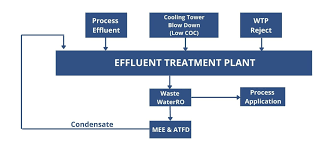EFFLUENT TREATMENT PLANT (ETP)
Zero Liquid Discharge (ZLD)



Zero Liquid Discharge (ZLD)
Zero Liquid Discharge (ZLD) is a water treatment process designed to eliminate the discharge of liquid waste into the environment. It aims to recover and reuse as much water as possible from industrial processes, ensuring that no wastewater is released into external ecosystems.
ZLD systems typically involve multiple stages of treatment, including filtration, evaporation, and crystallization, to remove contaminants and produce clean water that can be recycled or safely used again. The residual waste from the process is converted into solid waste, which can either be disposed of or reused, depending on its composition.
ZLD is commonly applied in industries such as power generation, chemical manufacturing, textile production, and pharmaceuticals, where water usage and pollution control are critical concerns. This approach helps industries comply with environmental regulations, conserve water resources, and reduce their environmental footprint.
Basic Usage of ZLD :
The following steps are involved in basic wastewater treatment:
- Primary Filtration & Treatment: Basic wastewater treatment, where large particles, suspended solids, and basic pollutants are removed through primary filtration techniques like sedimentation or clarification.
- Chemical Treatment: Coagulants and flocculants may be used to precipitate certain contaminants, making them easier to remove.
Advanced Usage of ZLD:
- Thermal Evaporators: In advanced ZLD systems, thermal evaporators are used to evaporate the remaining liquid from the concentrated brine, producing clean water vapor, which is condensed and reused.
- Crystallizers: The final step in achieving zero liquid discharge is crystallization, where the remaining solids from the brine are crystallized and separated out. These solids can often be repurposed, sold, or disposed of in an environmentally safe manner.
